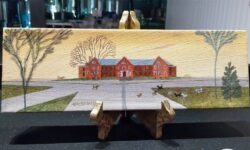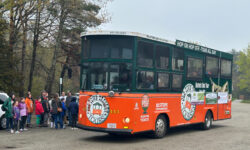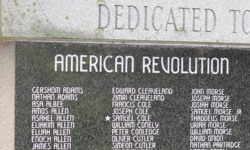[ccfic caption-text format="plaintext"]
By Richard DeSorgher
Hometown Weekly Correspondent
This week, 340 years ago, Medfield was trying to recover from the worst disaster ever to hit the town. While Hawaii will note Pearl Harbor and New York City will always remember 9/11, Medfield will never forget the events of February 21, 1676.
Some 17 residents and soldiers were killed, at least one resident was taken hostage and never returned; many were wounded, at least one was scalped and so bloodied that friends and neighbors could not recognize her, one was killed by friendly fire. Thirty-two houses besides barns, two mills and other buildings were burned. Horses and livestock were burned alive and an unknown number of Native Americans were killed.
It was in the midst of the King Philip War when somewhere between 300–1000 Native Americans crept into the town as part of their overall plan to burn down the English towns and reclaim their land. The war itself began in the summer of 1675 along the Rhode Island border and soon spread to the Connecticut River Valley.
After the Town of Mendon was attacked and abandoned, Medfield was the outermost town in the colony. For protection, the town had purchased a cannon, or “greate gune,” as it was called, which was placed outside the meetinghouse. On Feb. 11 the Town of Lancaster was attacked and also abandoned; it was only a matter of time before Medfield would be hit.
Men slept with their weapons by their side and carried them to their work in the field and even prayed holding on to their muskets. Many of the women and children gathered into the Stone House, one of five garrisons or forts built in town in the event of an attack. The Stone House was over the Charles River on South End Pond in the western part of what was then Medfield, today Millis. It was 70 feet long, two stories high and made completely of stone.
Soldiers from Boston and Cambridge had been sent to Medfield and were now scattered in the different houses throughout town. Sometime before daybreak on Feb. 21, several hundred Indians crept silently into the town and dispersed to various hiding places. The first fire broke forth at the home of Samuel Morse, who lived near the present corner of Main and Pound Streets.
Morse had uncovered an Indian hiding in the hay inside his barn and fled with his family to the garrison, near the present day Brook Street, when his house and barn went up in flames. Flames were now everywhere and lit up the pre-dawn sky. At the Thurston homestead, where the high school baseball field is located today, Thurston and his wife suffered an additional grave loss, for two of their seven children were killed; Margaret age 7 and Samuel age 18 months. Ten-year-old Mary Thurston was taken hostage the day of the attack and was brought with the natives to their stronghold in Central Massachusetts. She was never heard from again.
When the raid first began, Elizabeth Smith grabbed her year-and-a-half old son, Samuel, and raced towards the garrison. She, however, was overtaken by the Indians, who tomahawked her and threw Samuel to the ground. Samuel, however, did not die but was found after the battle, evidently just stunned, clinging to the body of his dead mother.
On Elm Street, by Mill Brook, Henry Adams, only had time to see his mill go up in flames before he was struck in the neck by a bullet and fell dead in his doorway. His two children managed to escape before his house like his mill was totally inflamed. His wife, Elizabeth, had remained at the house of Rev. Wilson (site of today’s town hall) and so escaped the attack at Elm Street; but a few hours after their house burned and her husband was killed, while in a room over the doorway of the house, a gun, in the hands of one the Boston soldiers who had been sent here, was accidentally fired; and the ball penetrating the floor of the room, mortally wounded Elizabeth Adams and she died the following night, a victim of friendly fire.
Tradition says that, having seen the Indians lurking about his place on what is today Foundry Street, Isaac Chenery took his wife and children and secreted them under a great rock at some distance from his house. Coming back alone as the attack was beginning, he saw the Indians preparing to burn his buildings. By himself, he ran towards the Indians beckoning to imaginary soldiers behind him. “Come on boys, there they are,” he shouted. The Indians figuring no one would run at the Indians without troops behind him, fled and his house and barn were saved. His house was one of the few in that part of town to survive.
Smoke billowed from the Castle Hill section of North Street as all the houses, except that of Joseph Allen which still stands today at 260 North Street, were torched. The Bridge Street section was totally destroyed. It was here that the attack left a most severe mark, with all ten homesteads left in ashes.
At the Dwight-Derby House, Timothy Dwight peered outside to learn what was going on and he was shot through the shoulder. He died six weeks later. Jonathan Fussell, then 99 years old, was burned alive inside his daughter and son-in-law’s house, being too old to escape. Thomas Mason and his two sons, Thomas, age 16, and Zachary, age 14, were overtaken by the Indians near a spring opposite their home on North Street and all three were killed.
It was early in the morning when two brothers, Jonathan and Eleazer Wood of the Sherborn side of the Charles River were sent into Medfield to get a couple of oxen. At about daybreak, the two brothers entered the barn where the oxen were kept. Here they were assailed by a party of Indians, who rushed into the barn, scalped them and left them for dead. Their bodies were discovered after the Indians had fled the town. Jonathan had died but Eleazer was alive and survived for several years. When the tragic news was finally brought to the Stone House, the wife of Jonathan Wood was immediately seized with pains of labor and soon afterwards gave birth to a daughter. Mrs. Wood, however, died a few hours later and the daughter became an orphan.
Town leaders were trying to organize a defense and bring the troops that had been sent here from Boston and Cambridge into some kind of order. This was most difficult as the troops were so scattered throughout the town.
An account written shortly after the battle said, “Some were killed as they attempted to fly to their neighbors for shelter. Some were only wounded and some were taken alive and carried off captive. In some houses the husbands running away with one child in one direction, the wife with another, of whom the one was killed, the other escaped.”
Gradually the town began to come together, the cannon or “great gun” was fired and the Native Americans began retreating across the Charles River, burning the bridges behind them. In total 14 settlers were killed along with two Boston soldiers, one Cambridge soldier and an unknown number of Native Americans. The war continued until the death of King Philip in August of 1676.
In proportion to population, the King Philip War produced greater casualties than any other war in American history. It would take Medfield and the rest of New England years before they fully recovered.
Richard DeSorgher is a Hometown Weekly Correspondent. To reach Richard, email news@hometownweekly.net.


























